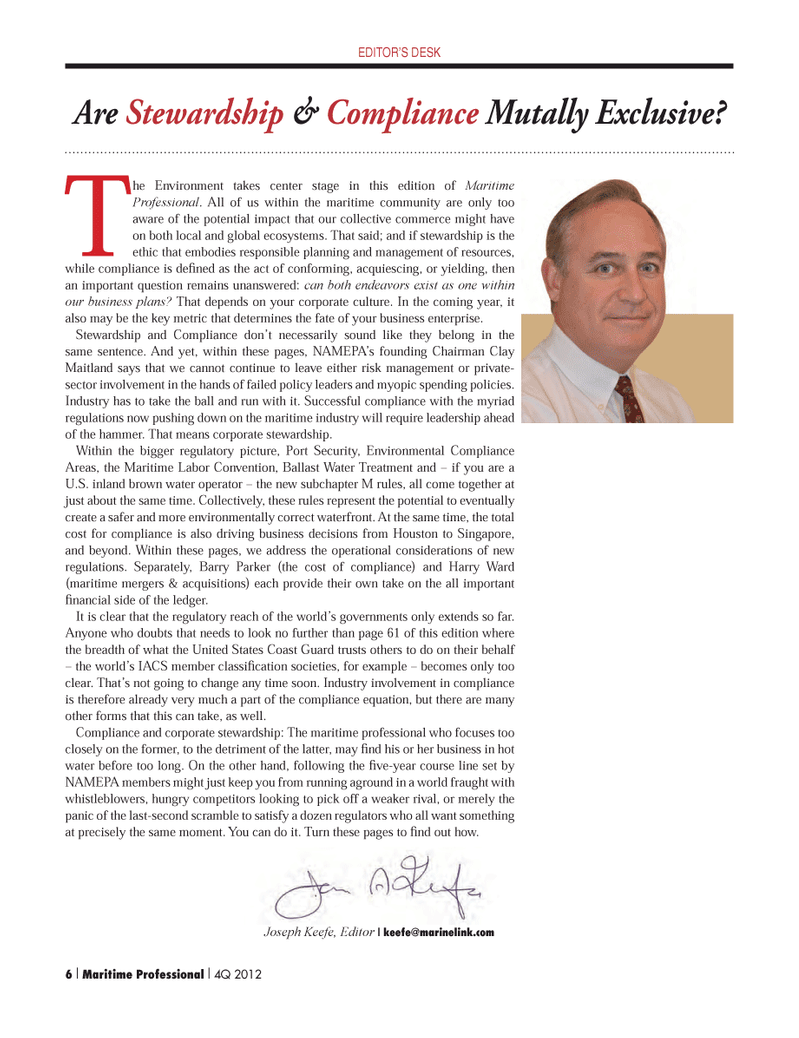
Page 6: of Maritime Logistics Professional Magazine (Q4 2012)
The Environment: Stewardship & Compliance
Read this page in Pdf, Flash or Html5 edition of Q4 2012 Maritime Logistics Professional Magazine
Are Stewardship & Compliance Mutally Exclusive? EDITOR?S DESK The Environment takes center stage in this edition of Maritime Professional . All of us within the maritime community are only too aware of the potential impact that our collective commerce might have on both local and global ecosystems. That said; and if stewardship is the ethic that embodies responsible planning and management of resources, while compliance is deÞ ned as the act of conforming, acquiescing, or yielding, then an important question remains unanswered: can both endeavors exist as one within our business plans? That depends on your corporate culture. In the coming year, it also may be the key metric that determines the fate of your business enterprise. Stewardship and Compliance donÕt necessarily sound like they belong in the same sentence. And yet, within these pages, NAMEPAÕs founding Chairman Clay Maitland says that we cannot continue to leave either risk management or private- sector involvement in the hands of failed policy leaders and myopic spending policies. Industry has to take the ball and run with it. Successful compliance with the myriad regulations now pushing down on the maritime industry will require leadership ahead of the hammer. That means corporate stewardship. Within the bigger regulatory picture, Port Security, Environmental Compliance Areas, the Maritime Labor Convention, Ballast Water Treatment and Ð if you are a U.S. inland brown water operator Ð the new subchapter M rules, all come together at just about the same time. Collectively, these rules represent the potential to eventually create a safer and more environmentally correct waterfront. At the same time, the total cost for compliance is also driving business decisions from Houston to Singapore, and beyond. Within these pages, we address the operational considerations of new regulations. Separately, Barry Parker (the cost of compliance) and Harry Ward (maritime mergers & acquisitions) each provide their own take on the all important Þ nancial side of the ledger. It is clear that the regulatory reach of the worldÕs governments only extends so far. Anyone who doubts that needs to look no further than page 61 of this edition where the breadth of what the United States Coast Guard trusts others to do on their behalf Ð the worldÕs IACS member classiÞ cation societies, for example Ð becomes only too clear. ThatÕs not going to change any time soon. Industry involvement in compliance is therefore already very much a part of the compliance equation, but there are many other forms that this can take, as well. Compliance and corporate stewardship: The maritime professional who focuses too closely on the former, to the detriment of the latter, may Þ nd his or her business in hot water before too long. On the other hand, following the Þ ve-year course line set by NAMEPA members might just keep you from running aground in a world fraught with whistleblowers, hungry competitors looking to pick off a weaker rival, or merely the panic of the last-second scramble to satisfy a dozen regulators who all want something at precisely the same moment. You can do it. Turn these pages to Þ nd out how. Joseph Keefe, Editor | [email protected] I Maritime Professional I 4Q 2012MP #4 1-17.indd 6MP #4 1-17.indd 611/12/2012 1:48:58 PM11/12/2012 1:48:58 PM

 5
5

 7
7
